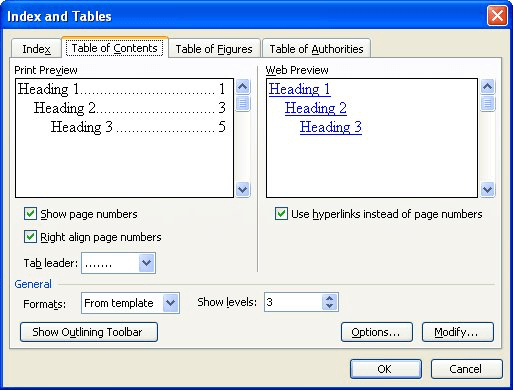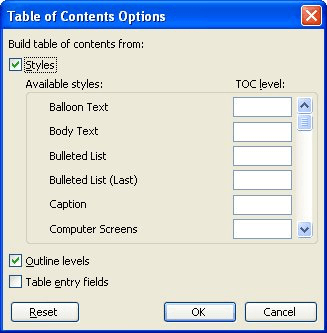Please Note: This article is written for users of the following Microsoft Word versions: 97, 2000, 2002, and 2003. If you are using a later version (Word 2007 or later), this tip may not work for you. For a version of this tip written specifically for later versions of Word, click here: Creating a TOC that Includes Specific Styles.
Written by Allen Wyatt (last updated January 21, 2023)
This tip applies to Word 97, 2000, 2002, and 2003
The normal way to create a table of contents (TOC) is to let Word automatically create one based upon the headings in a document. Each paragraph formatted with the Heading 1 style, Heading 2 style, or Heading 3 style is automatically pulled into the TOC.
There may be times when you want to create a TOC that includes paragraph styles other than the heading styles. For instance, you might have a paragraph style you've created for a specific purpose, such as for denoting all the product names in a document. You don't want to format these product names as headings; you instead want to format them with a special paragraph format that calls them out in some manner specific to your needs. (Let's say that you use the style named SpecialProduct for this purpose.) If you then, later, want to include those product names in a special TOC, you can follow these steps:

Figure 1. The Table of Contents tab of the Index and Tables dialog box.

Figure 2. The Table of Contents Options dialog box.
The result of creating this TOC in this way is that you have a list of all your products, and they are formatted in the list using the TOC 4 style. You can modify the TOC 4 style to reflect how you want the products to appear in the TOC.
You'll note that these steps used TOC level 4 (the TOC 4 style) for the products. The reason for this is simple—it allows you to leave TOC levels 1 through 3 (the TOC 1, TOC 2, and TOC 3 styles) for use in the regular TOC for the document. That way you can use different formatting for the regular TOC and the special product list TOC.
WordTips is your source for cost-effective Microsoft Word training. (Microsoft Word is the most popular word processing software in the world.) This tip (7000) applies to Microsoft Word 97, 2000, 2002, and 2003. You can find a version of this tip for the ribbon interface of Word (Word 2007 and later) here: Creating a TOC that Includes Specific Styles.

Do More in Less Time! An easy-to-understand guide to the more advanced features available in the Microsoft 365 version of Word. Enhance the quality of your documents and boost productivity in any field with this in-depth resource. Complete your Word-related tasks more efficiently as you unlock lesser-known tools and learn to quickly access the features you need. Check out Microsoft 365 Word For Professionals For Dummies today!
Linda's got a document that includes a table of contents that is based on headings in the document. When the headings ...
Discover MoreIf you use the TC field to mark what goes in a TOC, you may wonder why if you mark two lines together with the field they ...
Discover MoreWord, when creating a table of contents, should automatically make sure that the page numbers it shows correspond to the ...
Discover MoreFREE SERVICE: Get tips like this every week in WordTips, a free productivity newsletter. Enter your address and click "Subscribe."
There are currently no comments for this tip. (Be the first to leave your comment—just use the simple form above!)
Got a version of Word that uses the menu interface (Word 97, Word 2000, Word 2002, or Word 2003)? This site is for you! If you use a later version of Word, visit our WordTips site focusing on the ribbon interface.
Visit the WordTips channel on YouTube
FREE SERVICE: Get tips like this every week in WordTips, a free productivity newsletter. Enter your address and click "Subscribe."
Copyright © 2025 Sharon Parq Associates, Inc.
Comments